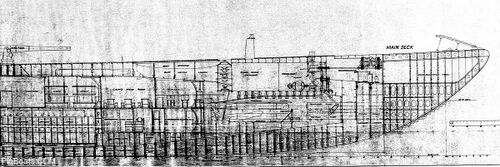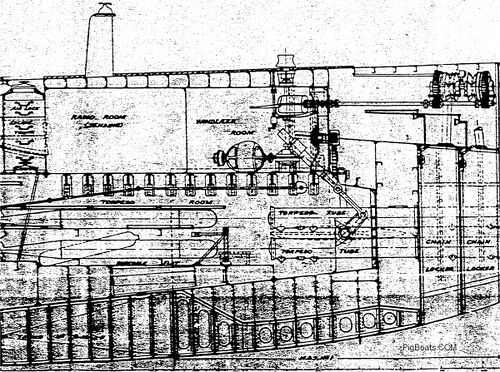166 Lines Drawings
USS V-4, Argonaut, SM-1, SS 166 Lines Drawings
There are two different sets of drawings shown here. The profile and top down drawings are from a many copied set of plans and is not as clear as the cross sectional drawings. Please note for reference when look at these cross section drawings that Port is always to the left of the image and Starboard is to the right. You are always looking from aft forward, just as directions and references are given aboard a real ship.

USS V-4 (Argonaut) Bow area. This drawing shows the multi deck interior of the Argonaut. Above the Torpedo Room is an entirely separate pressure hull that contained a Radio Room and a Windless Room. Access to these spaces seems to be through the forward escape trunk. Since the forward radio mast is above the Radio area this may have been just an equipment space.
Aft of the escape trunk is what looks like two curved bulkheads. These are just bulkhead stiffeners. At this point it becomes one pressure hull. This are the forward end of the main pressure hull containing the ships Galley and Crews Messing area plus the main Crews berthing. The deck below, under the galley, is the crews head and wash room and the ships refrigerator and freezer aft of the head. This deck was accessed via an aft facing ladder down from the mess decks. The room containing the reefer and freeze box also contained the machinery for cooling these small rooms. To access the head and washroom there was a passageway behind the ladder leading forward into these spaces.
Admiral James Fife, Jr., commanding submarine Task Force 42 in Brisbane, Australia, (where Argonaut was stationed), believing that all submarines, even ones specially adapted, such as Argonaut, should conduct war patrols when not actively involved in their speciality and had her ordered out. Argonaut was old, slow, under powered and unwieldy and totally unfit for the rough and tumble that an active war patrol needed. Regardless she was ordered out for such patrol and it became her last.
On January 10, 1943 Argonaut spotted a convoy of five freighters and their destroyer escorts. An Army aircraft was by chance flying overhead and witnessed Argonaut's attack. Argonaut hit at least one of the destroyers with her torpedoes, and they promptly counter attacked. A crew member on board the plane saw Argonaut's bow suddenly break the water at an unusual angle. It is this portion of the sub, seen above, that was seen and attacked by the Japanese destroyers Isokaze and Maikaze. The aircraft was out of ammunition and could offer no help to the submarine. It was apparent that a depth charge had severely damaged the submarine. The destroyers continued circling Argonaut and pumping shells into her bow. She slipped below the waves and was never heard from again. One hundred and two officers and men went down with the submarine.
US Navy Drawings

In this drawing shows a better view of the Radio Room, Windless Room and Torpedo Room. The diagonal shaft is for the operation of the Bow Planes.
US Navy Drawings
04
![]() 05
05
![]() 06
06
![]() 07
07
![]() 08
08
![]() 09
09
![]() 10
10
![]() 11
11
![]() 12
12
![]() 13
13
![]() 14
14
![]() 15
15
![]() 16
16
![]() 17
17
![]() 18
18
![]() 19
19
![]() 20
20
![]() 21
21
![]() 22
22
![]() 23
23
![]() 24
24
![]() 25
25
![]() 26
26
![]() 27
27
![]() 28
28
![]() 29
29
![]() 30
30
Page created by:
Ric Hedman & David Johnston
1999 - 2023 - PigBoats.COM©
Mountlake Terrace, WA, Norfolk, VA
webmaster at pigboats dot com
